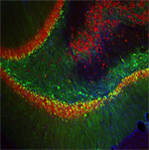A new factor in depression? Brain protein discovery could lead to better treatments
Study in humans & rats shows more physical changes in depressed brains
September 8, 2015
Low. Down. Less than normal. That’s what the word depression means, and what people with depression often feel like. But sometimes, depression can mean too much of something – as new research shows.
The discovery, about a protein called fibroblast growth factor 9 or FGF9, goes against previous findings that depressed brains often have less of key components than non-depressed brains.
In this case, people with major depression had 32 percent more of FGF9 in a key part of their brain than people without the condition. In rats, raising FGF9 levels artificially led to depression-like behavior changes, and repeated social stress caused brain FGF9 levels to rise.
Taken together, the findings provide more evidence that depression is a physical illness. If FGF9 or its effects prove to be a good target for drugs, the finding could eventually help lead to better medications for the mental health condition that affects millions of Americans.
Read the full article at UofMHealth.org »
Read the publication abstract at PNAS »


